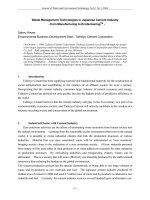from books to films
Bạn đang xem bản rút gọn của tài liệu. Xem và tải ngay bản đầy đủ của tài liệu tại đây (3.43 MB, 25 trang )
From books… To films!
Film adaptation - the transfer of a
written work to a feature film.
Film adaptation is as common as the
development of original screenplays and it
includes the use of :
non-fiction (including journalism)
autobiography
comic book
plays
other films
300 by Frank Miller (graphic novel)
Alice in Wonderland
by Lewis Carroll
The Bone Collector
by Jeffery Deaver
Beloved by Toni Morrison
Cloudy with a Chance of Meatballs
by Judi and Ron Barrett
The Curious Case of Benjamin Button
by F. Scott Fitzgerald(based on the short
story)
Doctor Dolittle by Hugh Lofting
Dune by Frank Herbert
Eragon by Christopher Paolini
The Exorcist
by William Peter Blatty
The Fellowship of the Ring
by J.R.R. Tolkien
Fight Club by Chuck Palahniuk
Inkheart by Cornelia Funke
Interview with the Vampire by Anne Rice
The Jungle Book by Rudyard Kipling
Jumanji by Chris Van Allsburg
Nanny McPhee by Christianna Brand
(based on the “Nurse Matilda” book series)
Moby Dick by Herman Melville
Sleepy Hollow by Washington Irving
– based on the short story
The Tale of Despereaux by Kate
DiCamillo
The Wizard of Oz by L. Frank Baum
Where the Wild Things Are by Maurice Sendak
Zathura: A Space Adventure
by Chris van Allsburg
Yes Man by Danny Wallace
One of the most popular
film adaptations, with over
252 derived films
(according to
www.imdb.com) and the
inspiration of countless
parodies, cartoons, TV
programmes is Dracula.
This famous character has
entered the universal ,
collective imagination and
is here to stay.
The phenomenon started
with the publication of
Dracula, an 1897 novel by
Irish author Bram Stoker.
Famous for introducing the
character of the vampire
Count Dracula, the novel tells
the story of Dracula's
attempt to relocate from
Transylvania to England, and
the battle between Dracula
and a small group of men
and women led by Professor
Abraham van Helsing.
Stoker’s Dracula was influenced
by:
research on European folklore
stories of vampires
Emily Gerard's 1885 essay
Transylvania Superstitions
Sheridan Le Fanu's 1871 novel
Carmilla
Varney the Vampire, a lengthy
serial by James Malcolm Rymer
John Polidori’s 1819 novel The
Vampyre, where the image of a
vampire portrayed as an
aristocratic man appeared for the
first time
Historians have connected the
character of Dracula to Vlad the
Impaler, who reigned from 1456–
1462 and is said to have killed from
40,000 to 100,000 European civilians
(political rivals, criminals and anyone
else he considered "useless to
humanity"), mainly by using his
favorite method of impaling them on a
sharp pole.
Vlad the III rd is revered as a folk hero
by Romanians for driving off the
invading Turks. The numbers of his
victims are most likely exaggerated.
The plot:
Jonathan Harker, a young English
lawyer, travels to Transylvania to
conclude a real estate transaction with
a nobleman named Count Dracula.
Although the elderly Dracula seems to
be a well educated, hospitable
gentleman, Harker realizes soon that
he is held prisoner and that the count
is actually undead. Harker escapes, but
Dracula reaches England by boat and
tracks down Mina, Harker’s fiancee
and attacks her friend, Lucy. The expert
van Helsing is called to deal with the
disease Lucy seems to suffer from and
not long passes before they find they
are the victims of a vampire. The
characters join forces and ultimately
destroy the monster as it was trying to
reach his home-castle.
The most popular film adaptations:
Director: Tod Browning
Writers: Bram Stoker, Hamilton Deane
Stars:
Bela Lugosi, Helen Chandler and David
Manners
Tagline: The story of the strangest passion the
world has ever known!
Bela lugosi as dracula
MINA (Helen CHANDLER) aND dracula
The most popular film
adaptations:
dracula
s
a
E
E
L
R
E
H
CHRISTOP
Peter cu
Helsing
N
a
v
s
sh i n g a
Director: Terence Fisher
Writers: Bram Stoker, Jimmy Sangster
Stars:
Peter Cushing, Christopher Lee and
Michael Gough
Tagline: The terrifying lover who died - yet lived!
The most popular film
adaptations:
Gary oldman as Dracula
Winona Ryder as MINa
Anthony Hopkins as VAN
helsing
Keanu reeves as harker
Director: Francis Ford Coppola
Writers: Bram Stoker, James V. Hart
Stars:
Gary Oldman, Winona Ryder and
Anthony Hopkins
Tagline: The blood is life.
A video from Dracula (1995) –
Mel Brooks’s parody:
Little Dracula is a British series of children's books and an American animated television series that originally aired
on FOX. Little Dracula revolves around a green-skinned, child vampire who aspires to be like his father, Big Dracula,
yet also enjoys rock 'n roll and surfing. Little Dracula also has a monstrous friend named Werebunny, and his
Transylvanian family of strange characters is often threatened by the villainous Garlic Man.
Dracula in popular culture
Stage – An acclaimed Edward Gorey production, starring Frank Langella as the Count was
staged in 1977.
Radio - In 1938, Orson Welles and John Houseman chose Dracula to be the inaugural
episode of the new radio show.
Novels - Dracula has inspired many literary tributes or parodies, including Stephen King's
Salem's Lot, Stephenie Meyer’s Twilight Saga
Short Stories - Shepard, Leslie. 1977. The Dracula book of great vampire stories.
Comics - Marvel comics version of Dracula: Tomb of Dracula by Marv Wolfman
Games and video games - Tepes is a mysterious vampire in Vampire: The Masquerade.
Anime and manga - In 1980, Toei Animation produced the TV anime movie Yami no Teiô
Kyûketsuki Dracula, based upon Marv Wolfman and Gene Colan's Tomb of Dracula.
Television – True Blood, Vampire Diaries, Buffy the Vampire Slayer
Cartoons – Little Dracula, Scooby-Doo and the Ghoul School
Others - The General Mills cereal mascot Count Chocula is a vampire who craves Count
Chocula cereal rather than blood.









